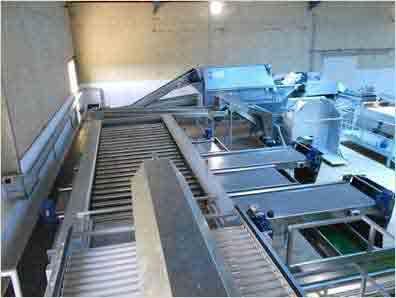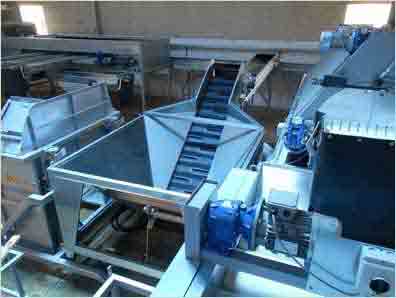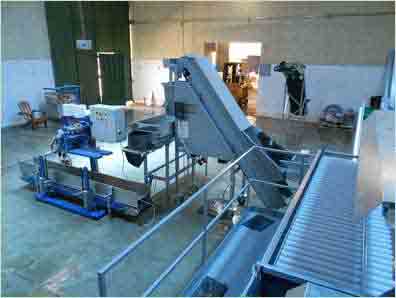Installation, commissioning of a post harvest handling line #2
LinkExchange SearchMe WhatWeDo AboutUs Sitemap Next page Installation, commissioning of a post harvest handling line #3

Once we had the machinery in place, we began the wiring phase, to power the motors and transmit the signals from the sensors.
Installation and commissioning of an Eqraft BV potato, onion and carrot handling line
Part 2

Whilst we were installing the machines, the electricians fitted the metal channels (which also came in the containers) and pulled through the power cables for the 37 motors, and the many signal cables to automate the system.

The numbered cables connecting each machine, motor and sensor with the control panel are fed through these channels, which surround the entire line. The electricians connected the line whilst the Dutch technician connected the cables to the control panel below.


The potato and carrot washer with its input elevator.

The potato washer output. The black triangle in the middle is the washer output. Opening or closing it controls the washing intensity in a straightforward way.

The potato dryer with rollers (made using a spongy material). At the bottom of the picture you can see the conveyor belt. The dryer and belt are installed on a sort of small train, so that the produce can be dried (potatoes) or not dried (carrots).

Here you can see the potato dryer, next to the small conveyor (by-pass) for carrots, which are not dried.

To the left is the box tipper, which tips the produce with different sizes into a chute with an inbuilt elevator, so that they are temporarily kept separate (as they left the grading machine) The temporarily separated produce then re-enters the line to possibly be washed, inspected, weighed and packed.

Carrots tend to bunch together at the sides of the conveyors belts. This machine separates them on the conveyor belt, so that they don't all appear on the inspection table at one side, making inspection easier.

The inspection table lighting has been connected.

The machine in the centre is the weigher. The produce passes from here onto a two-directional belt, which takes it to two different packing machines.

The weigher, packing machine and bag stitcher, which prints your logo, are the final part of the line.
Internet connection, with the “long-distance technical support” programme.

All of the motors are powered by frequency converters, which make it easy to adjust the entire line with great precision. The grey blocks at the bottom are those converters. The blocks with little green and blue lights are the brains of the facility, a programmable logic controller (PLC). The box with the blue front on the top right is the device which connects to the internet.

WIFI internet connection, with the “long-distance technical support” programme.
This internet connection, through the “long-distance technical support” programme, enables ERCmachinery to offer online support from the Netherlands in the event of an error.
In fact, we have used it twice during the last nine months:
- After three months of operation, the client asked for a programming modification so that the first part of the line (up to the boxes below the grading machine) could be used to receive potatoes, grade them, place them in wooden boxes and store them in a storage facility. They also wanted to tip the boxes with the tipper (for onions, for example) and inspect them, weigh them and pack them. What they really wanted was for the first part of the line to work independently from the second part. We consulted the Netherlands and the next day, in just 20 minutes, they reloaded the modified programme over the internet and it worked: Since then, the client has had two independent lines.
- On another occasion, the client called us in a state of panic. They couldn't boot up the line. They had followed all of our instructions, read all of the manuals, switched the control panel off and on again, but all to no avail. They had a stack of orders and it was Sunday afternoon (10 pm in the Netherlands). Even so, a technician back in the Netherlands turned on his laptop at home, connected to the system and saw that one of the emergency stop buttons had been pressed in error. It just needed to be switched off: Problem solved in half an hour from the Netherlands, on a Sunday.

The physical transitions between the machines are all properly adjusted. If they are maladjusted, the line will throw the produce all over the place. Adjusting a line requires a lot of skill. Onions bounce around like balls, carrots like cigars and potatoes like pears. Here is another example of a motor with its control switch. In this case, it powers one of the inspection tables, which also has a hydraulic controller, enabling the speed of the table to be changed locally, without touching the control panel.

The emergency buttons are at the end, in a strategic location. They are necessary to stop the entire line in case of a real emergency.

Control panel with it's touch screen display, form where the whole line is controlled.
Control panel and managing the line.
Part of the control panel from which the entire line is managed. Under normal circumstances, there is no reason to open the control panel, which has its own filtered air ventilation.
On the monitor above you can see a plan of the line, indicating the programme and the machines which are working at that moment.
Black button on the top left: RESET. This reboots the system with its normal settings, following a power cut or emergency stop.
Red button, top centre: Emergency stop.
The red light to the right lights up whenever something malfunctions.
Green light, bottom left: Start the line.
Red button in the centre: Stop the line in the following order. The first machine stops first, then the second, and so on until all of the machines have stopped.
Green light to the right, remains lit up during normal operation.
With the five black switches below you can choose which process to use.
Each switch has a name, in English, with Spanish translations on the post-it notes below.
On the eleventh day, we were ready for the first test with produce.
We also had to adjust the transitions of the produce between the different machines.
By “transitions” we mean the parts of the line where the produce leaves one machine and joins the next, especially in lines with a high processing capacity. Each product behaves differently. At these transition points, the onions roll and bounce like balls, the carrots roll around like tubes and the potatoes roll and bounce like... well, potatoes, for want of a better description. Once these transition points are well adjusted, we affix all of the supports that connect the machines with bolts to the concrete floor.
To mechanise your post harvest processes:
contact us:
Telephone:
+1 239 3002374
or use our (preferable)
our contact form
Address: Farm San Isidro, Volcán, Panama.

